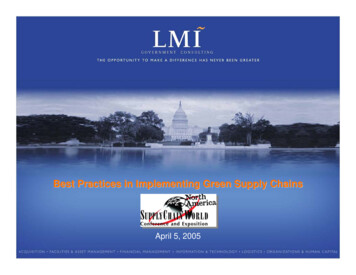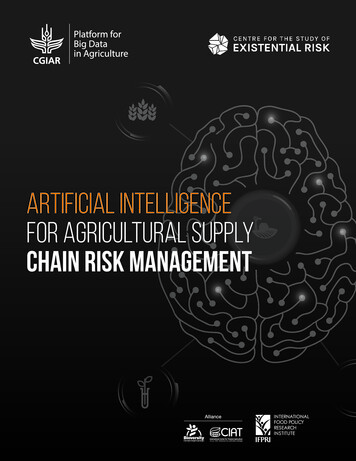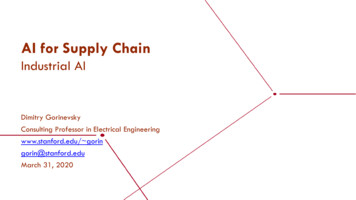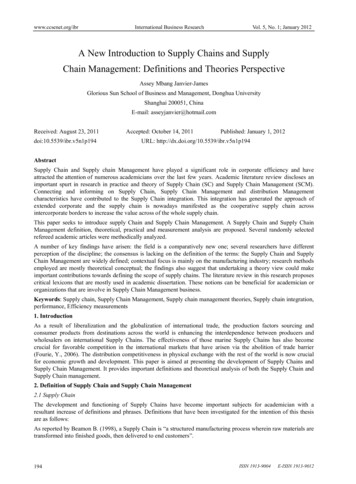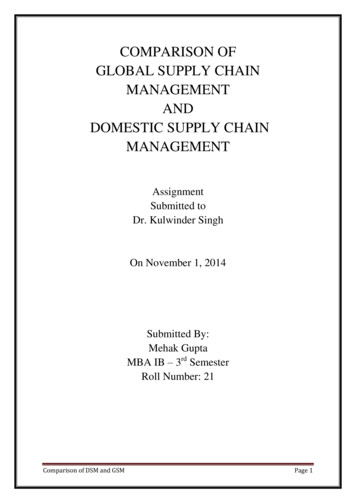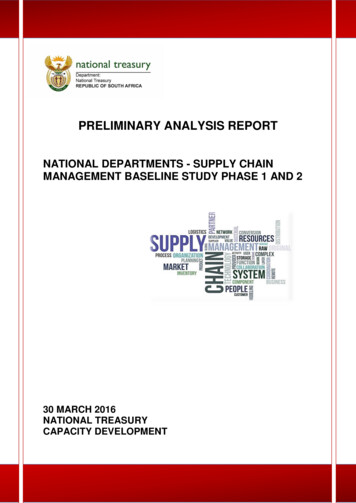
Transcription
PRELIMINARY ANALYSIS REPORTNATIONAL DEPARTMENTS - SUPPLY CHAINMANAGEMENT BASELINE STUDY PHASE 1 AND 230 MARCH 2016NATIONAL TREASURYCAPACITY DEVELOPMENT
NATIONAL GOVERNMENT DEPARTMENTS SUPPLY CHAIN MANAGEMENTBASELINE STUDY PHASE 1 & 2Table of Contents1.EXECUTIVE SUMMARY . 32.INTRODUCTION AND OVERVIEW. 42.1Background . 42.2Scope . 52.3General comments . 52.4Challenges and limitations. 62.5National Government Departments Data Analysis . 62.5.1 Operational Supply Chain Management Structures . 62.5.2 Funded, Filled and Vacant Posts . 7Figure 1: National departments’ vacancies as percentage of funded post . 72.5.3 Supply Chain Management Functions . 8Figure 2: National government departments SCM functions . 82.6National Government Departments Individual Data Analysis. 102.6.1Demographics . 10Figure 3: Nationality and Race . 10Figure 4: Gender and Age . 10Figure 5: Occupational Roles: National Level . 11Figure 6: Salary levels of officials at National Level . 11Figure 7: Officials in acting positions at National Level . 122.6.2Qualifications . 12Figure 8: Highest Secondary Qualifications . 12Figure 9: Professional Affiliation . 13Figure 10: Completed Qualifications at National Level . 13Figure 11: Description of Completed Qualifications at National Level. 14Figure 12: Qualifications officials are interested in undertaking. 142.6.3Training . 15Figure 13: Supply Chain Management Courses completed . 15Figure 14: Supply Chain Management officials are interested in undertaking . 162.6.4Skills Profile . 16Figure 15: Public Sector Experience vs. Private Sector Experience . 16Page 1 of 33
NATIONAL GOVERNMENT DEPARTMENTS SUPPLY CHAIN MANAGEMENTBASELINE STUDY PHASE 1 & 2Figure 16: Experience: Public Sector SCM vs. Private Sector SCM. 173.General Findings . 174.Conclusion . 19ANNEXURE 1- SCM BASELINE ROADSHOWS . 20ANNEXURE 2: SUPPLY CHAIN MANAGEMENT FUNCTIONS PER NATIONAL GOVERNMENTDEPARTMENT . 22Page 2 of 33
NATIONAL GOVERNMENT DEPARTMENTS SUPPLY CHAIN MANAGEMENTBASELINE STUDY PHASE 1 & 21.EXECUTIVE SUMMARYThe objective of the Supply Chain Management(SCM) baseline study is in linewith National Treasury Strategic Plan: 2015/2019 Programme 5: FinancialAccounting and Supply Chain Management Systems, strategic objective 5.5which is to develop Supply Chain Management capacity.On 10 December 2014 the Cabinet Committee for Governance andAdministration adopted the recommendations proposed in the CabinetMemorandum No: 25 of 2014 pertaining to SCM reforms and capacitydevelopment. Cabinet noted the strategic importance of SCM in service deliveryand in achieving South Africa’s developmental and transformational objectives.In order to position SCM as a strategic function, Cabinet approved a range ofsteps to reform the SCM system which includes amongst others, that the SCMperformance criteria be included in the performance agreements of AccountingOfficers from 1 April 2015 and that Accounting Officers to conduct a capacityreview of SCM staff and take remedial action where required.The strategic objective statement of the Supply Capacity Building chiefdirectorate within the Office of the Accountant-General at National Treasury isto research, develop and implement interventions that will contribute toimproved Supply Chain Management capacity, capability and performance inall three spheres of government, through institutional, organisational, individualand stakeholder development.The Supply Chain Management (SCM) Baseline Study seeks todetermine the number, demographic profile andqualifications of SCM officials (practitioners and managers)that are currently employed in the national, provincial andlocal spheres of government.This is a consolidated preliminary SCM baseline studyreport in respect of national government departments.The main source of information for the exercise is asurvey completed by SCM managers and practitioners.Government is the single biggest spender in South Africaand must promote good financial management in orderto maximise delivery through the efficient and effective use of limited resources.A well performing Supply Chain Management function is therefore critical toachieving the strategic objectives and goals of any government institution.The third National Skills Development Strategy (NSDS III) recognises that thecapacity of the public sector lags far behind what is expected of it, and in manyPage 3 of 33
NATIONAL GOVERNMENT DEPARTMENTS SUPPLY CHAIN MANAGEMENTBASELINE STUDY PHASE 1 & 2areas critical to the nation’s needs, there are serious skills gaps. To achieve thegoals of a developmental state it requires a public service that is skilled andcapable to deliver quality services efficiently and effectively.Public procurement is a core function of public financial management andservice delivery. Government institutions are under increasing pressure todeliver and demonstrate success in terms of both service delivery andorganisational performance. State institutions must ensure that their employeeshave the necessary knowledge, skills and attributes required to undertake theirduties competently.The accounting officer must ensure that the Supply Chain Managementfunction is adequately structured and staffed with appropriately qualified andcompetent professionals able to support management in achieving theorganisational mandate, strategy and goals.2.INTRODUCTION AND OVERVIEWDuring the period 2015 to 2016, the National Treasury conducted a baselinestudy in public sector SCM to determine a baseline capacity review of publicsector SCM in order to help government with its goal linked to PresidentialOutcome 12: “to improve planning, resource allocation, performance andservice delivery.”There are two phases to the project, the first being the collection oforganisational data and the second being an individual survey.Phase one (1) required each national department to provide the number offunded, filled and vacant posts in the SCM Units, including the names of SCMofficials, their job title and email address, together with an approvedorganisational structure of the SCM function in their respective institutions.Phase two (2) required each individual to complete an online questionnaire todetermine the demographic, qualifications, courses and experience ofindividual SCM officials in the entity.2.1BackgroundSerious capacity and capability constraints exist across governmentpertaining to public Supply Chain Management (SCM) across the threespheres of government.Page 4 of 33
NATIONAL GOVERNMENT DEPARTMENTS SUPPLY CHAIN MANAGEMENTBASELINE STUDY PHASE 1 & 2National Treasury intends to design, develop and deliver public sector specificinterventions aimed at improving the capacity and capability of public sectoremployees in SCM.A systematic capacity and capability needs easements provides a realisticbasis upon which to plan, budget, direct, monitor and evaluate effective andefficient Capacity Development initiatives and Education, Training andDevelopment (ETD) programmes.The results of the baseline study will inform the development of responsive andappropriate capacity development solutions and enable the National Treasuryand state institutions to channel resources into the areas where they willcontribute the most to capacity development interventions, employee trainingand development, as well as enhancing staff morale and organisationalperformance.2.2ScopeThis report on the SCM baseline study involves forty three (43) nationalgovernment departments. The provincial departments and municipalitiesreport will be finalised and released in the second and third quarter of the2016/2017 financial year respectively.It should be noted that information presented below is a preliminary analysisof the SCM baseline study of phase 1 and 2. There may be no correlation ofthe number of surveys completed between the two phases due to thefollowing reasons: Structural changes and changes in staffing as a result of appointments,resignations and retirements; and New employees that were not part of the phase 1 survey, however, havecompleted phase 2 surveys.The data reflects the submissions from respective national departments.SCM baseline road shows were conducted with various national departmentsin order to assist them to complete both phase 1 and 2 surveys (for a list ofthese road shows conducted, please refer to Annexure 1).2.3General comments It should be noted that the information presented below is a preliminaryanalysis of the Supply Chain Management (SCM) Baseline Study Phase1 and Phase 2;Page 5 of 33
NATIONAL GOVERNMENT DEPARTMENTS SUPPLY CHAIN MANAGEMENTBASELINE STUDY PHASE 1 & 22.4 The data reflects the submissions from the respective nationalgovernment departments; and The data needs to be updated periodically to cater for structural changesand changes in staffing due to appointments, resignations andretirements.Challenges and limitationsThe study is dependent on the full cooperation and support of all governmentinstitutions and individual SCM employees. Some departments were nonresponsive; others submitted incomplete, incoherent or inaccurateorganisational data. The data submitted required extensive validation.Various surveys were completed without the following information: Organisational structures; Incomplete surveys which had to be re-done for the relevant departmentsto confirm the information; No individual e-mail addresses loaded on the system in order to conductphase 2 survey; Incorrect individual e-mail addresses provided; Some departments and staff completing the survey more than once.Duplicated surveys had to be deleted; Departments not completing both phase 1 and 2 timeously; Incoherent information and a number of abbreviations which do not makesense provided; Information technology (IT) system being down most of the time andsome staff not being able to access the survey due to different ITplatforms; and Some staff completing the survey without understanding the questionand therefore providing irrelevant information.Some surveys questionnaires fields not properly structured in order to conduct thedata analysis effectively and efficiently.The most important findings are summarised in section five (5) of this report.2.5National Government Departments Data Analysis2.5.1 Operational Supply Chain Management StructuresA review of submitted responses to the surveys indicates that a number ofnational departments do not have adequate SCM structures. There are noPage 6 of 33
NATIONAL GOVERNMENT DEPARTMENTS SUPPLY CHAIN MANAGEMENTBASELINE STUDY PHASE 1 & 2standardised SCM structures; some structures do not include all the elementsof the public sector SCM Model such as Demand Management, ContractAdministration/Management, Disposal Management, Supply Chain RiskManagement or Supply Chain Performance Management; and other structuresprovide for combinations of the different elements of the public sector SCMModel.This is understandable due to different sizes of the departments, mandates andstrategic plans. For example, in some departments the Asset Managementfunction and structure fall under the Finance Management Unit and not withinthe SCM units.2.5.2 Funded, Filled and Vacant PostsFigure 1: National departments’ vacancies as percentage of funded postSUPPLY CHAIN MANAGEMENT NATIONAL GOVERNMENT DEPARTMENTSFILLED POSTS AND VACANCIESDescriptionFundedFilledVacantSouth African Police12111111100Vacancies as %of FundedPositions8%Public Works62048713321%Justice and 18%Correctional Services1781453319%Agriculture Forestry and Fisheries1551371812%Water and Sanitation136944231%Rural Development and Land Reform1201071311%Health666512%International Relations & Cooperation6354914%Environmental Affairs585800%The Presidency55431222%State Security Agency514924%Statistics South Africa4942714%Mineral Resources4437716%Human Settlements424025%Social Development373700%Transport35241131%Trade and Industry353239%Higher Education and Training3325824%Government Communication andInformation System3124723%Page 7 of 33
NATIONAL GOVERNMENT DEPARTMENTS SUPPLY CHAIN MANAGEMENTBASELINE STUDY PHASE 1 & 2Telecommunications and PostalServicesNational Treasury31211032%292813%Public Service & 29%Independent Police and InvestigativeDirectorateBasic Education2218418%202000%Science and Technology1917211%Energy181800%Arts and Culture1815317%Sport and Recreation South Africa1711635%Performance Monitoring andEvaluationCooperate Governance171616%171616%National School of Government76114%Office of the Chief Justice149536%Small Business Development11011100%Military Veterans87113%Women76114%Economic Development74343%Public Enterprises6600%Traditional Affairs53240%Home Affairs747045%Total3882334553714%Six national departments have 0% vacancy rates. Twelve departments have highvacancy rates excedding 20%.Some of these departments have recently advertisedthe positions and are in the process of filling them.2.5.3 Supply Chain Management FunctionsFigure 2: National government departments SCM functionsNATIONAL DEPARTMENTS SCM FUNCTIONSSupply Chain Management FunctionFilledVacantTotalDemand Management23843281Acquisition Management57292664Contract Administration/Management8823111Transversal Contracting2112210621791241Logistics ManagementPage 8 of 33
NATIONAL GOVERNMENT DEPARTMENTS SUPPLY CHAIN MANAGEMENTBASELINE STUDY PHASE 1 & 2Asset Management53646582Disposal Management1528160Supply Chain Risk Management37643Supply Chain Performance Management9238130Infrastructure Procurement66874* Other48193574Total33455373882* Explanation of OtherOther is a combination of SCMFunctions: Examples are litiesTransport ManagementFleet ManagementProperty ManagementSupport ServicesTravel, Accommodation and CorporateAccountsResearch and DevelopmentMoveable Asset ManagementLogistics, Disposal and ProcurementTotalFigures 2 shows that the majority of employed SCM staff is in the LogisticsManagement function with few staff employed in Contract Administration/Managementand SCM Performance Management functions. The least of officials are withinTransversal Contracting and Supply Risk Management functions.The Supply Chain Performance Management function has the highest vacancy rate of29% followed the by Contract Administration/Management with a vacancy rate of 21%.Page 9 of 33
NATIONAL GOVERNMENT DEPARTMENTS SUPPLY CHAIN MANAGEMENTBASELINE STUDY PHASE 1 & 22.62.6.1National Government Departments Individual Data AnalysisDemographicsFigure 3: Nationality and nownFigure 3 above indicates that 99% of employees in national departments are SouthAfrican citizens. The racial composition of staff is in line with the nationaldemographics.Figure 4: Gender and AgeAgeGender60%57%1%Unknown50%43%12%12%51 yrs- 70 yrs40%46yrs-50 yrs30%37 yrs- 45 yrs20%32yrs-36 yrs31%21%22%26 yrs- 31 yrs10%0%0%FemaleMaleUnknown2%18yrs-25 yrs0%10%20%30%40%An analysis by gender, represented in Figure 4 above indicates that males are in theminority, i.e. 43% of the total staff. This is also in line with the national demographicsdue to more female representation. 45% of staff is below 36 years of age. 55% of staffis above the age of 36. Only 2% of staff is below 25 years of age.Page 10 of 33
NATIONAL GOVERNMENT DEPARTMENTS SUPPLY CHAIN MANAGEMENTBASELINE STUDY PHASE 1 & 2Figure 5: Occupational Roles: National LevelOccupational RolesNational Level2%3%6%12%39%38%JuniorMiddleSeniorManagement Management ManagementServiceService (MMS) Service (SMS)Post Levels 9- Post Levels 11- Post Levels 13Post Levels 1-6 Post Levels rvisoryLevelUnknownUnknown2%The majority of staff in national departments is employed at practitioner andsupervisory levels.Figure 6: Salary levels of officials at National LevelSalary Level30%25%25%18%20%14%15%10%5%0%0% 0% 0%3% 3% 3%5%16%7%2%1% 0% 1%2%The majority of staff is between salary level 5 and 8.Page 11 of 33
NATIONAL GOVERNMENT DEPARTMENTS SUPPLY CHAIN MANAGEMENTBASELINE STUDY PHASE 1 & 2Figure 7: Officials in acting positions at National LevelActing orNot Acting0%4%YesNo96%UnknownOnly 4% of officials are in acting positions in national departments.2.6.2 QualificationsFigure 8: Highest Secondary QualificationsHighest Secondary Qualifications1% 3%32%MatricGrade 12 or Standard 1065%Grade 11 or Standard 9Grade 10 of Standard 8Only 4% of staff has no matric qualification as represented by 1% of staff havingGrade 11% and 3% having only Grade 10 secondary school qualifications.Page 12 of 33
NATIONAL GOVERNMENT DEPARTMENTS SUPPLY CHAIN MANAGEMENTBASELINE STUDY PHASE 1 & 2Figure 9: Professional AffiliationProfessional Affiliation97%Not Applicable1%SA Pharmacy Council0%0%SAICA0%0%SAIBA0%0%Mind Sport0%0%Joint Matriculation 0%0%IIA0%0%CIPS1%0%20%40%60%80%100%120%Only 2% of officials belong to a professional body or association. Out of that 2%,only 1% belong to CIPS.Figure 10: Completed Qualifications at National LevelCompleted Qualifications0%13%National Certificate25%National DiplomaBachelors DegreeHonours0%0%1%Masters19%41%DoctorateNot ApplicableUnknown60% of staff has either a national diploma or undergraduate degree-i.e. acombination of national diploma (41%) and bachelor degree (19%). Only 1% haspost graduate qualification.Page 13 of 33
NATIONAL GOVERNMENT DEPARTMENTS SUPPLY CHAIN MANAGEMENTBASELINE STUDY PHASE 1 & 2Figure 11: Description of Completed Qualifications at National LevelDESCRIPTIONTOTAL IN %TOTAL IN VALUEAccounting11%151Auditing2%22Asset icing0%1Procurement Management2%27Purchasing Management3%38Project Management0%4Public Administration6%82Public Management10%141SCM2%28SCM Risk Management0%1Strategic SCM0%1Store ot Applicable30%413Total100%1373Only 19% of staff has completed SCM related qualifications with majority of coursesnoticeable under accounting and public management.Figure 12: Qualifications officials are interested in undertaking2%Interested QualificationsNational Certificate7%National Diploma13%Bachelors DegreeHonours5%4%68%1%MastersDoctorateUnknownPage 14 of 33
NATIONAL GOVERNMENT DEPARTMENTS SUPPLY CHAIN MANAGEMENTBASELINE STUDY PHASE 1 & 220% of staff has shown an interest in doing either a national diploma or bachelor’sdegree. 10% of staff has shown an interest in doing post graduate qualification.2.6.3 TrainingFigure 13: Supply Chain Management Courses completedSCM Courses CompletedNational LevelThe Prevention, Detection and Combating of 1%Training on the Revised Preferential 1%Execute a Sourcing Strategy0%Develop a Sourcing Strategy0%Conduct Initial Assessment for Strategic Sourcing0%Supply Chain Performance Management2%Municipal Supply Chain Management0%Demand Management5%Contract Management (MFMA)0%Contract Management (PFMA)5%Supply Chain Risk Management1%Bid Committees (MFMA)0%Bid Committees (PFMA)7%Acquisition Management5%Disposal Management2%Asset Management7%Logistics Management7%Supply Chain Management for the Public ServiceUnknown0%14%41%5% 10% 15% 20% 25% 30% 35% 40% 45%Figure 13 indicates that none of the staff has completed municipal SCM courses. Thisraises questions with regard to the appropriate support to be provided to Municipalitiesby provincial treasuries support staff given the amount of challenges at localgovernment level.Only 14% of staff has completed an introductory course in Public Sector SCM. 5% ofstaff has completed a Demand Management course. 5% of staff has completedAcquisition Management course. 7% of staff has completed Logistics Managementcourse. 7% of staff has completed Asset Management course.Page 15 of 33
NATIONAL GOVERNMENT DEPARTMENTS SUPPLY CHAIN MANAGEMENTBASELINE STUDY PHASE 1 & 2Figure 14: Supply Chain Management officials are interested in undertakingInterested SCM CoursesNational LevelThe Prevention, Detection and Combating of 2%3%1%3%1%Execute a Sourcing StrategyConduct Initial Assessment for Strategic Sourcing6%Municipal Supply Chain Management1%9%Contract Management (MFMA)1%10%Supply Chain Risk Management8%1%Bid Committees (PFMA)6%7%Disposal Management4%6%Logistics Management8%8%Unknown16%0%2%4%6%8% 10% 12% 14% 16% 18%Figure 14 shows that only a minority of staff are interested in doing SCM coursesfocusing on municipalities. Few members of staff are interested in attending trainingcourses focusing on the various elements of the public sector SCM model. Eachelement does not exceed 10%.2.6.4 Skills ProfileFigure 15: Public Sector Experience vs. Private Sector ExperienceNumber of Years Experience at National LevelPublic Sector vs. Private SectorMore than 35 years1% 6%0%6%More than 20 years1%UnknownBetween 6 years and 10 years15%8%More than 10 years0%Less than 1 Year27%24%13%Between 1 year and 5 yearsNumber ofyears inPrivate Sector26%73%2%0%Number ofyears in PublicService10% 20% 30% 40% 50% 60% 70% 80%Page 16 of 33
NATIONAL GOVERNMENT DEPARTMENTS SUPPLY CHAIN MANAGEMENTBASELINE STUDY PHASE 1 & 2Figure 15 shows that 27% of staff has been in the public service for more than 10years whereas 73% of employees have less than 1 year in the private sector.Figure 16: Experience: Public Sector SCM vs. Private Sector SCMNumber of Years Experience at National LevelPublic Sector SCM vs. Private Sector SCM7%1%UnknownMore than 35 years0%2%More than 20 years0%Number ofyears inPrivateSector SCM9%3%More than 10 yearsBetween 6 years and 10years48%0%0%7%Between 1 year and 5 yearsLess than 1 Year34%83%4%0%Number ofyears inPublic SectorSCM20%40%60%80%100%An analysis of the public sector SCM number of experience versus public sector,represented in figure 35 above, indicate that majority of staff has been in the publicsector for more than 10 years. 83% has been employed in private sector SCM for lessthan 1 year.3.General FindingsOverall the analysis reveals the following regarding national departments: A number of government departments do not have adequate SCMstructures. There are no standardised SCM structures across governmentdepartments; some structures primarily cater for Acquisition and LogisticsManagement and do not include all the other elements of the public sectorSCM Model; There is a high vacancy rate in terms of the phase 1 report which could havean impact on the level of performance and fulfilling the approved mandatesby government;Page 17 of 33
NATIONAL GOVERNMENT DEPARTMENTS SUPPLY CHAIN MANAGEMENTBASELINE STUDY PHASE 1 & 2 There is insufficient capacity in operational SCM units to provide theappropriate level of performance required to support service delivery bygovernment departments; Not all SCM managers and practitioners have completed the phase 2individual survey in relation to phase 1 organisational data survey and thiswas beyond the control of team collecting the data; The demographics of officials in terms of nationality, race, gender andpeople with disabilities is in line with the national demographic profile of thecountry; 55% of staff is above the age of 36 and their job experience could be usedto provide on the job training for newly employed officials and existingofficials in government departments. They could also be trained as coachesand mentors. Very few officials are aware that there is an SCM Professional Body andAssociations which is useful to enhance their knowledge and experienceoutside the government environment. This was ascertained from the actualsurveys completed and from the road shows conducted. The benefits ofbelonging to a professional body or a relevant Association, amongst othersare: networking opportunities, broadening knowledge: education, attendingconferences and seminars, joining communities of practice and sharingSCM good practice. Although 61% of officials have tertiary qualifications there is lack of relevantSCM academic qualifications; There is inadequate uptake of opportunities for attending short term SCMtraining courses.Overall, one of the biggest challenges as reported in Auditor-General’s general reportdated 2014/2015 is that national departments have challenges in attracting andretaining qualified and competent SCM officials.It is therefore evident from the survey conducted that there is a correlation betweenthe AG s findings and the results emanating from the survey conducted by theNational Treasury that the majority of SCM employees have been in government formany years without appropriate SCM related academic qualifications and relevanttraining.Page 18 of 33
NATIONAL GOVERNMENT DEPARTMENTS SUPPLY CHAIN MANAGEMENTBASELINE STUDY PHASE 1 & 24.ConclusionThe accounting officer must ensure that the Supply Chain Management function isadequately structured and staffed with appropriately qualified and competentprofessionals able to support management in achieving the organisationalmandate, strategy and goals.From the surveys conducted, it is revealed that there are a number of importantissues which need immediate and urgent attention. Amongst others, some of theseissues to be addressed are: standardisation and implementation of SCM structuresacross all spheres of government based on their strategic plans and mandates.The results of the survey provide a platform to prioritise the filling of critical vacantposts, the development of relevant SCM academic qualifications, on the job traininginitiatives, coaching and mentoring programmes at senior management level.Adequate resources must therefore be mobilised to ensure the implementation ofthese interventions, including allocation of adequate training budgets.This also provides an opportunity to professionalise the SCM sector to be on parwith other financial management disciplines and host a public procurementcolloquium in order to address some of the challenges highlighted in this report.Page 19 of 33
SCM BASELINE ROAD SHOWSNATIONAL GOVERNMENT DEPARTMENTSANNEXURE 1- SCM BASELINE ROADSHOWS1Agriculture, Forestry & Fisheries (2)X2Basic Education 14/03/20163Government Communication and Information System 16/03/20164Correctional Services (9)X5Economic Development 6HealthX78910Human SettlementsMineral ResourcesNational School of GovernmentNational Treasury ent Police Investigative Directorate 15/03/2016121314Planning, Monitoring & EvaluationStatistics South AfricaTourism (2)X 14/03/201617/03/20161516Trade and IndustryEnvironmental Affairs 16/03/201617/03/20161718Arts & Culture17/03/2016Transport X19WomenX20Telecommunications & Postal Services 18/03/20162122Science & TechnologyPublic EnterprisesX 16/03/201623Labour 15/03/201624Office of the Chief Justice & Judicial AdministrationX16/03/2016
NATIONAL GOVERNMENT DEPARTMENTS SUPPLY CHAIN MANAGEMENT BASELINE STUDY PHASE 1 & 2SCM BASELINE ROAD SHOWSNATIONAL GOVERNMENT DEPARTMENTSANNEXURE 1- SCM BASELINE ROADSHOWS2526Home AffairsHigher Education & TrainingXX27Energy 18/03/2016282930Sport & Recre
Management or Supply Chain Performance Management; and other structures provide for combinations of the different elements of the public sector SCM Model. This is understandable due to different sizes of the departments, mandates and strategic plans. For example, in some departments the Asset Management




